How to drill a water well: practical options and drilling technologies
For a comfortable life in a country house or in a private house, you need your own source of clean water.This can be a shaft or tube well, that is, a well. The device of the second option is a priority due to the lower investment of effort, time, and money.
We will tell you how to drill a water well with your own hands or with the help of invited drillers. In both cases, knowledge of the technological intricacies of the process will be useful to the owner of the site. Those who want to drill and arrange an autonomous water source themselves will find a detailed guide with valuable recommendations.
The content of the article:
Features of mechanical drilling
The services of a hired team are not cheap, but the work is usually completed quite quickly and professionally. In order for the process to proceed as efficiently as possible, it is necessary to create suitable conditions for the operation of drilling equipment.
First you need to choose a place:
- for a well;
- for placing a drilling rig;
- for auxiliary equipment;
- for draining waste water;
- for storing tools and materials.
It is recommended to carry out all work on a flat area, its optimal dimensions are 4x12 m. In addition, care should be taken to ensure the free passage of equipment: a drilling rig, a water carrier, etc.
It is desirable that the width of such an entrance be about three meters. If an electrical wire is stretched above the work site at a height of less than two meters, it will have to be removed or relocated.
The location of the drilling rig depends on its type and dimensions. For drilling with a UGB machine stationary located on the machine, entry to the site to the drilling point and free exit must be provided. It should be remembered that when moving on cultivated land, freight transport can “sit” in the ground and get stuck for a long time.
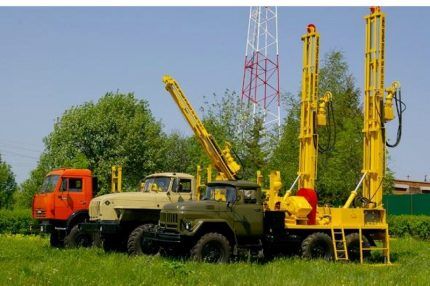
Portable team drilling rig, which can be made or rented, placed in any place convenient for work. She usually does not have a high drilling rig.
However, it is worth considering that water intake structure should not be located near the foundation, because In the process of many years of pumping out water, soil particles will be washed out along with it. As a result, the mineral base under the foundation will be weakened due to erosion.
Secrets and subtleties of finding a place for a water well are given here. We recommend reading the article dedicated to this issue.
Overview of Basic Methods
Drilling methods vary depending on the type of soil, but they operate on the same principle. The rock must be destroyed, removed to the surface, and then the walls of the resulting hole must be strengthened. To destroy rock, many drilling tools have been invented that allow cohesive, non-cohesive and rocky soils to be drilled and brought to the surface.
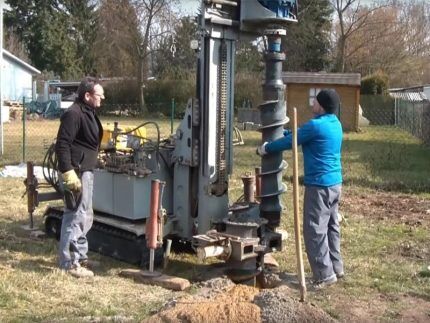
There are other ways to destroy soil: using explosions, heat treatment, electrical discharges, but they are usually not suitable for wells.
The following are used to extract destroyed rock: drilling technologies:
- mechanical;
- hydraulic;
- pneumatic;
- combined.
The most common is the mechanical method, which uses equipment such as glasses, spoons, chisels, bailers, augers, etc. Hydraulic methods involve washing out rock using a large volume of water, which is pumped under pressure into the excavation.
Pneumatic methods, which use compressed air to remove loose rock, are used much less frequently. Most often they combine mechanical and hydraulic methods. The solution that is fed into the well during mechanical drilling facilitates the movement of the drill string and cools it.
With methods and tools used in manual drilling of wells, read the article, which examines this very interesting issue in detail.
Principle of hydraulic drilling technology
Hydrodrilling is a fairly common method. The working fluid is pumped into the face under pressure using a pump. It comes out, carrying with it particles of destroyed rock. The spent solution is collected in a separate container for settling.

The water is then reused. In this case, you should constantly study the characteristics of the soil in order to understand which layer the drill is passing through at this moment.When there is extraneous water in the well, you can skip the aquifer and continue unnecessary drilling.
A mixture of water and clay is needed as a hydraulic solution on non-cohesive soils. Clay particles will additionally bind the rock and strengthen the walls of the well. But if during the drilling process you have to go through a clay layer, there is no need to make a solution. The clay particles will dissolve in the water naturally as the water moves inside the trunk.
On calcareous soils, hydrodrilling with clean water is considered effective. This breed has the ability to absorb water. If the solution is consumed at an accelerated pace, we can talk about reaching the aquifer and begin the final stage of drilling.
Strengthening the walls of the well
As the well deepens, the casing pipe is lowered into the hole and its length is increased. Steel alloy structures are considered the most suitable for this.
Both seamless and welded pipes are considered suitable. Threads are usually used to connect individual elements, but high-quality welding is also acceptable. To extend the life of the well and provide it with a filter, a plastic liner with a perforated first link is placed in the casing pipe.
There is an opinion that on cohesive soils with a relatively shallow drilling depth, you can first go through all the layers of rock to the aquifer, and then lower the pipe immediately along the entire length of the well. But experienced drillers believe that it is better not to take risks even if the probability of collapse is low.
Pumping and arrangement of the structure
After reaching the aquifer, drilling is continued to go deeper into the ground by about a meter. After this, a plastic column with a filter is installed in the excavation and well pumping, i.e. pump out a large amount of water from it until it becomes clean.
Pumping out contaminated water can take several days. If a solution was used during drilling, more effort will be required to clean the structure. Sometimes it is recommended to use another cleaning method. Water is supplied into the finished well from above under pressure to clean the space around the lower end of the pipe.
They lower it into the pumped well submersible pump, equip the head, etc. The owner is issued a passport for the hydraulic structure. It reflects a number of important indicators, such as depth, well flow rate, its statistical and dynamic levels.
How to make a well yourself?
The high cost of hiring a hired team encourages amateur craftsmen to look for methods of manual drilling. These methods are considered low-cost, but require time and effort. The principle of performing the work is the same as with mechanized drilling. It is necessary to crush the rock and remove it, gradually lowering the casing pipe into the face.

Soil destruction is carried out using various types of drills: bailers, spoons, glasses, coils. Instead of a drilling rig, a metal or wooden tripod is installed. Its center should be located exactly above the location chosen for the well, and its dimensions should allow two or three employees to be near the work site.
A winch block is also placed at the top. This design will make it easier to remove the tool with soil.You can rotate the winch manually, but it is more convenient to use an electric motor for rotation, if possible.
The use of homemade drilling rigs
You can make a drill yourself or purchase a ready-made one. There are different types of tools for manual drilling. It is selected depending on the type of soil. For example, it is better to use a spoon drill on sand, and clay layers should be passed through with a coil.
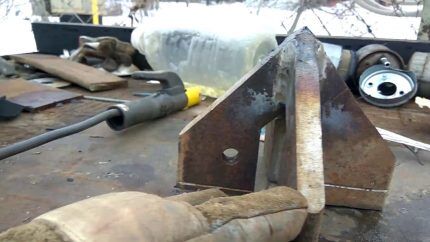
First, make an initial hole, about a meter deep. It sets the direction for the movement of the main tool. Then the selected drill is lowered into the hole, several turns are made and it is removed along with the soil destroyed and captured by the drill.
The top edge of the drill rod fits into the hole inside the tripod to help maintain the correct drilling direction. It is not necessary to use a tripod. The guide post can be of a different shape.
The procedure is repeated again and again. The well is deepened, and additional links are attached to the top rod in the column immersed in the ground, which are secured with threads or clamps. Usually it takes two people to turn the drill; sometimes another person is needed to hit the tool from above to make the work easier.
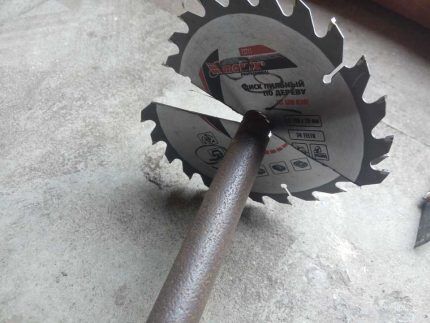
But this is not necessary either. Many craftsmen share their experience of constructing a well alone. But they note that in this case they will have to work for quite a long time.The entire process can take several weeks or even months. If possible, it is better to invite a partner.
Using a chisel and bailer
If you need to go through rocks, you will need a chisel. In shallow excavations, typical for the development of summer cottages, the need to use a chisel rarely arises. Most often this happens if the drill string comes up against a boulder that completely blocks the shaft or if large pebbles are stuck in the casing.
A chisel is literally used to break a stone. The tool is attached to a winch cable mounted on a tripod, lifted and thrown down several times. Then the destroyed rock is removed using a bailer or washed out with drilling fluid.
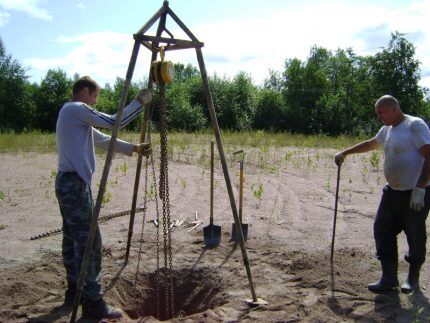
The bailer is a long and narrow glass made of pipe. Its diameter is slightly smaller than the hole for the well. The bottom of the pipe is covered with a valve so that soil that gets inside does not fall back out.
On cohesive clay soils bailer not used due to too low drilling speed and low efficiency. It is used for drilling non-cohesive rocks: sand, gravel and crushed stone deposits.
To free the projectile from its contents, a narrow slot is made along such a bailer, through which the destroyed soil is simply unloaded onto the ground next to the well. If the bailer becomes clogged with a lump of loam or a large pebble becomes jammed, the bailer is cleaned through the slot with a metal rod.
The bailer is attached to the cable, like a chisel, and is also thrown down several times, and then taken to the surface and freed from the soil that has packed inside.This is a very effective method for loose and water-saturated soils. This tool is especially useful when water-saturated sand needs to be practically scooped out.
A bailer with a valve can also be used for cleaning sandy wells, the filter of which has not been cleaned for a long time.
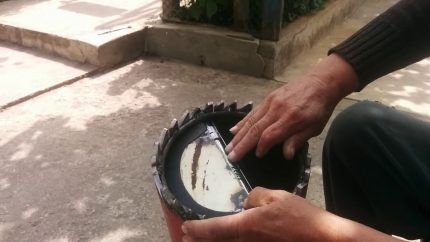
A homemade well also needs to be pumped up, just like a structure made industrially. You will need a pump capable of pumping out water and sand. Some have successfully used inexpensive “Baby” models for this.
They are easy to repair if they break down, and if the device burns out during operation, you can always buy a new one. A conventional submersible or surface pump should not be used for these purposes, since the expensive device will quickly deteriorate during such non-intended use.
Some useful tips
No matter how expensive the services of drillers are, you should not hire a team that offers too low a price. It is quite possible that such savings will have to be paid for in the quality of the hydraulic structure. If you want to save money, it makes sense to think about drilling a well in winter.
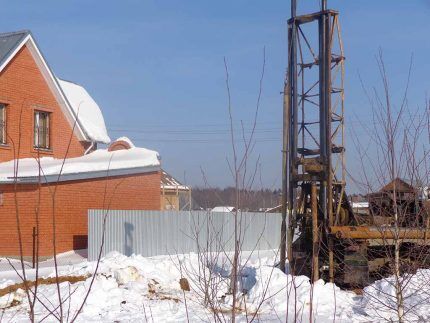
Drillers' workload decreases at this time, and they offer good discounts. Even the most experienced driller cannot accurately predict how drilling operations will progress. Each such structure is individual.
It is also necessary to remember that payment is made according to the actual drilling depth, and only the predicted value is indicated in the contract. The acceptance certificate should be signed only after clean water without visible impurities of sand and other similar contaminants begins to flow into the house.
But the drillers are not responsible for the presence or absence of microelements or microorganisms in the resulting water. A few days later, after the start of active operation of the well, a water sample should be taken and sent to the laboratory for testing.
Based on the results, you will need to decide which filters need to be installed at the entrance of the water supply to the house. This rule is also mandatory for wells that are made independently.
Conclusions and useful video on the topic
Video #1. Detailed experience of self-hydraulic drilling:
Video #2. Industrial option for creating a well:
Well drilling methods are varied, but they are time-tested. By collaborating with an experienced team, you can almost always get a reliable and durable structure. But a self-created water source can last for several decades.
Would you like to talk about how you or your neighbors drilled a well in their dacha? Share your own experience or useful information on the topic of the article. Please leave comments in the block below, post photos with a step-by-step demonstration of the process, and ask questions.




We made a well on the site in order to save on water for irrigation, because... If you water your garden from the central water supply, it’s easier to go broke. And so you spend only on electricity for the pump pumping water and on the operation of the irrigation system.The drilling was, of course, by hired workers with special equipment. technology. After drilling, a long pipe was driven into the well so that the earth did not crumble and nothing was deformed. Everything was done in a few hours. Naturally, we had to spend money, but there have been no complaints about the well for several years now. And our neighbors decided to save money. We fiddled around for several days, and in the end the mud was spread in the yard, but, as far as I remember, we didn’t even get to the water. Then they also called the brigade)))
It is very correctly noted that in such matters you should not save. We drilled a well in a country house last winter to a depth of 15 meters, the team made a 30 percent discount. And this despite the fact that the drilling process was not easy. But the neighbor hired would-be specialists who offered cheap services... And it turned out that he paid twice to correct the errors.